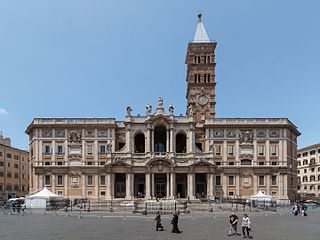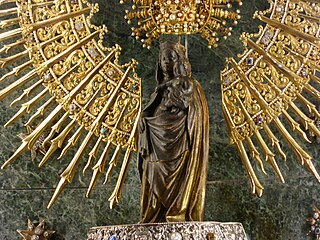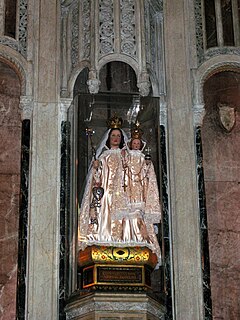
A shrine to the Virgin Mary is a shrine marking an apparition or other miracle ascribed to the Blessed Virgin Mary, or a site on which is centered a historically strong Marian devotion. Such locales are often the destination of pilgrimages.

The term Black Madonna or Black Virgin tends to refer to statues or paintings in Western Christendom of the Blessed Virgin Mary and the Infant Jesus, where both figures are depicted as black. The Black Madonna can be found both in Catholic and Orthodox countries.

Our Lady of the Pillar is the name given to the Blessed Virgin Mary in the context of the traditional belief that Mary, while living in Jerusalem, supernaturally appeared to the Apostle James the Greater in AD 40 while he was preaching in what is now Spain. Those who adhere to this belief consider this appearance to be the only recorded instance of Mary exhibiting the mystical phenomenon of bilocation. Among Catholics, it is also considered the first Marian apparition, and unique because it happened while Mary was still living on Earth.

Our Lady Aparecida - Our Lady Revealed - is a title of the Blessed Virgin Mary in the traditional form associated with the Immaculate Conception associated with a clay statue bearing the same title. The image is widely venerated by Brazilian Catholics, who consider her as the principal patroness of Brazil. Historical accounts state that the statue was originally found by three fishermen who miraculously caught many fish after invoking the Blessed Virgin Mary.

Our Lady of the Rosary, also known as Our Lady of the Holy Rosary, is a title of the Blessed Virgin Mary.

The Basilica of Our Lady of Zapopan and the abbey of Our Lady of Expectation of Zapopan are a 17th-century Franciscan sanctuary built in downtown Zapopan, in the state of Jalisco, México.
The name of the city of Buenos Aires, the capital of Argentina, means "Good Airs" or "Fair Winds" in Spanish. There are other places, mostly in the Americas, that go by the same name.

The Basilica and National Shrine of Our Lady of Consolation is a minor basilica of the Roman Catholic Church and a shrine to the Virgin Mary, operated by the Conventual Franciscan Friars. It is located in Carey, a village in Northwest Ohio. It was made a national shrine by the U.S. Conference of Catholic Bishops.

The Basilica of Our Lady of Good Health, also known as Sanctuary of Our Lady of Vailankanni, is a Marian shrine located at the small town of Velankanni in Tamil Nadu, South India. The Roman Catholic Latin Rite Basilica is dedicated to Our Lady of Good Health. Devotion to Our Lady of Good Health of Velankanni can be traced back to the mid-16th century, and is attributed to three separate miracles at the sites surrounding the Basilica: The apparition of Blessed Mary and the Christ Child to a slumbering shepherd boy, the healing of a handicapped buttermilk vendor, and the rescue of Portuguese sailors from a deadly sea storm. These accounts are oral lore with no written record or attested sources to support them.
Shrine of Our Lady of Matara is a Roman Catholic church devoted to the Virgin Mary, in the town of Matara, Sri Lanka. The shrine houses a statue of the Virgin Mary holding the infant Jesus. Though the statue's origins are unknown, church officials claim that it is 400 years old. The statue has been damaged, lost and recovered more than once, most recently during the 2004 tsunami in Asia, which damaged the shrine and killed 24 people attending Sunday Mass. The church celebrated its centenary year in 2007.
The Basilica of Our Lady of Bonaria is a Roman Catholic shrine to the Blessed Virgin Mary located in Cagliari, Italy. The Basilica is part of a complex of buildings which make up the Shrine of Our Lady of Bonaria. The Basilica and the other structures are under the administration of the Order of the Blessed Virgin Mary of Mercy, a Religious Order which has overseen the care of the shrine continuously since 1335.

Our Lady of Charity, also known as Our Lady of El Cobre, Nuestra Señora de la Caridad del Cobre or "la Vírgen de la Caridad", is a popular Marian title of the Blessed Virgin Mary known in many Catholic countries.

Our Lady of Luján is a celebrated 16th-century statue of the Virgin Mary, mother of Jesus Christ. The image, also known as the Virgin of Luján, is on display in the Basilica of Luján in Argentina. The feast day of Our Lady of Luján is May 8.

Our Lady of Peace and Good Voyage also known as Our Lady of Antipolo and the Virgin of Antipolo, is a 17th-century Roman Catholic wooden image of the Blessed Virgin Mary venerated in the Philippines. The image, a Black Madonna that represents the Immaculate Conception, is enshrined in Antipolo Cathedral in the Sierra Madre mountains east of Metro Manila.

The Minor Basilica and Convent of Nuestra Señora de la Merced is a church, designed in the Baroque style known as Churrigueresque, located in Lima, Peru. The church was built under Friar Miguel de Orenes in 1535. The Blessed Virgin Mary of Mercy, the patroness of the Peruvian Armed Forces, is venerated in the Basilica. The Mercedarians not only evangelized the region but helped develop Lima by building many of the churches preserved today.

Our Lady of the Most Holy Rosary - La Naval de Manila is a venerated title of the Blessed Virgin Mary associated with the same image in the Philippines.















